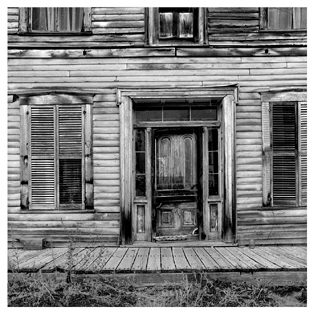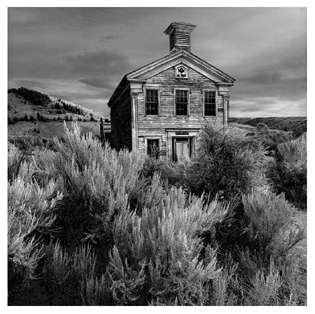. . . . . . .
. . . .

Ghost
Town, Idaho, 1996
.
. . . . . . . . .
"These
overlapping dots generate the subtle shades of gray necessary for a fine
print, and generate more detail in the image."
|
Hardware
Computer: For a PC system intended for
photography, both color and black-and-white, I recommend a Pentium II (266
MHz minimum) with 256 MB ram (128 MB minimum), at least a 4 GB hard drive,
8 MB video, 32x (or faster) CD-rom, 17- or 21-inch, 0.26 dot pitch, high-refresh
rate monitor, and a SCSI-based system. A CD-rom writer and a high capacity
removable drive are valuable add-ons. The speed and the large amount
of ram are necessary to make changes to images in a reasonable time frame
for good creative work.
. . . .
. . . . . . .
Printer: The photo printers from Epson with six inks have made it
possible to make prints that certainly look photographic. Yes, it is
possible to make inkjet prints that compare favorably to silver-based
prints.
You may
be surprised to learn that superior black-and-white prints result from printing
black-and-white as "color" images. If "monochrome" is chosen in the
printer driver, only the black ink cartridge gets used. Shades of gray
are achieved by spacing the black dots printed on the paper, resulting in
much empty space in the printed image. If "color" is chosen, all six
inks are used, essentially filling the print with colored dots. These
overlapping does generate the subtle shades of gray necessary for a fine
print, and generate more detail in the image. Epson printers are capable
of producing very round dots, particularly on their glossy and film papers,
which results in superior prints.
The Epson
photo printers are optimized to print images that consist of 240-300 pixels
per inch (ppi). This should not be confused with the 720 dpi to 1440
dpi capability of these printers. These printers do not print ordinary
halftones, but use "error-diffusion dithering". In low-detail regions,
like clouded skies, the resolution is reduced, and the shades of gray
increased. In high detail regions, this situation is
reversed. |
"Yes, it is
possible to make inkjet prints that compare favorably to silver-based
prints."
|
. . . . . . .
.

Masonic
Lodge, Montana, 1996
.
. . . . . . . . .
 |
Printer resolution in dpi should also not be confused with ordinary
photographic image resolution. My previous tests ("Understanding Resolution
Part I: Lens, Film, and Paper," D&CCT, Vol. 12, No. 2, Mar/Apr 1991)
have shown that in a conventional black-and-white photographic print, one
can resolve only about four lines per millimeter (lp/mm) with the normal
human eye, unaided. I also found that – using high-quality cameras,
lenses, papers, and – the usual methods of printing – the resulting
prints had a maximum resolution of about 13 lp/mm as examined by a loupe.
Yes, I know that a higher number of lp/mm can be imprinted on photographic
paper, but I'm referring to ordinary photographs of ordinary
scenes.
My tests
have shown that Epson Photo prints have an image resolution slightly exceeding
the maximum resolution of the eye. This accounts for the fact that
such prints may appear photographic. However, examination with a loupe
will generally prove the photographic print to have more actual
detail.
Printing
papers and inks are important, as well. Epson photo papers and inks
make it possible to print almost all of the tones from black to
white.
>>>

|
"You may be
surprised to learn that superior black-and-white prints result from printing
black-and-white as "color"
images."
One problem
with inkjet prints is that they are not archival in the photographic
sense. However, this situation is improving, and I look forward to
the time when inkjet prints will last as long as conventional prints.
Also, bear in mind that my conventional black-and-white negatives are archival,
and of course I can still make conventional photographic prints from my negatives
at any time. Since the images are stored digitally, images made today
can be reprinted as necessary in the future. One word of caution, though:
just because an image is stored digitally does not mean that the image file
will give the same print on other printers, now or in the future. Each
image must be optimized for the printer and inks in use to achieve the subtle
tones of a fine black-and-white print.
(Incidentally:
I don't mean to suggest that other manufacturers don't make printers as good
for photography as Epson's. I simply have no experience using any other
printer.)
|
.
. . . . . . . . . . . . . . . . . . . . . . . . . . . . . . .
.
 * * 
.
. . . . . . . . . . . . . . . . . . . . . . . . . . . . . . . .
.
|

